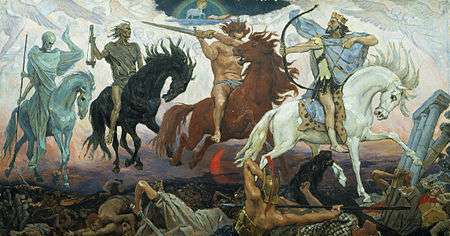Apocalypse (chess variant)
_gameboard_and_init_config.png)
Apocalypse is a chess variant invented by C. S. Elliott in 1976.[1][2] The players each start with two horsemen and five footmen on a 5×5 board. The two sides make their moves simultaneously.
The game was featured in Issue 53 of Games & Puzzles magazine.
Game rules
The starting setup is as shown. Horsemen and footmen move and capture the same as knights and pawns in chess, except footmen do not have a double-step option on their first move. For each turn, each player secretly writes down his move, then the players simultaneously declare them. The following rules apply:
- If they moved to the same square, a horseman captures a footman. Same-type pieces are both removed from the board.
- If a capture was declared using a footman, but the piece to be captured moved from its square, the footman move still stands. (The move converts to a diagonal step instead of a capture.)
- If a declared move is illegal, the player incurs a penalty point.
A footman promotes to horseman when reaching the last rank, but only when the player has less than two horsemen. Otherwise the player must redeploy the footman to any vacant square.[3]
End of game
A player wins by being first to eliminate all of the opponent's footmen. Accumulating two penalty points forfeits the game. A stalemate is a draw.

(V. Vasnetsov, 1887)
References
- ↑ Pritchard (1994), p. 9
- ↑ Pritchard (2007), p. 181
- ↑ "Apocalypse". The World of Abstract Games • João Pedro Neto.
Bibliography
- Pritchard, D. B. (1994). The Encyclopedia of Chess Variants. Games & Puzzles Publications. ISBN 0-9524142-0-1.
- Pritchard, D. B. (2007). Beasley, John, ed. The Classified Encyclopedia of Chess Variants. John Beasley. ISBN 978-0-9555168-0-1.
External links
- Apocalypse at BoardGameGeek
- Apocalypse a simple program by Ed Friedlander (Java)